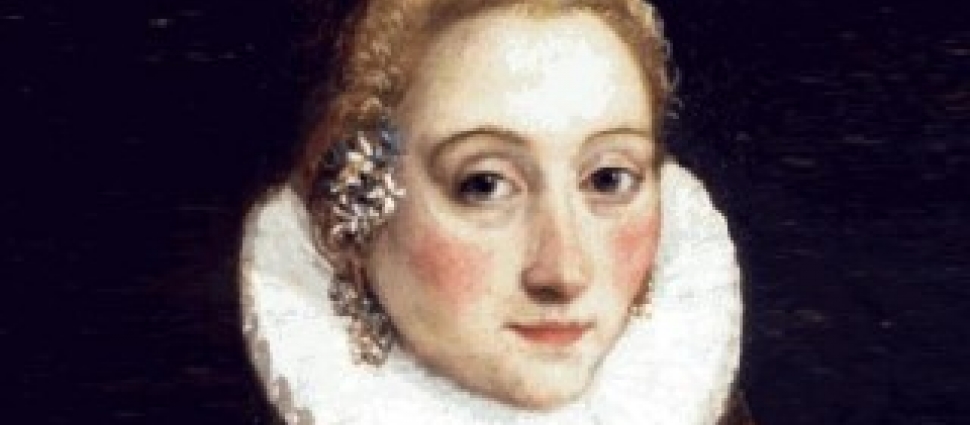Elisabeth Cruciger – The First Lutheran Female Hymnwriter

Elisabeth Cruciger – The First Lutheran Female Hymnwriter
Elisabeth Cruciger is considered the first Lutheran female hymnwriter. Born around 1500 as Elisabeth von Mezerite to a noble family in Pomerania (a region in today’s Poland), she entered as a child the cloister at Marienbush Abbey, near Treptow (today’s Trzebiatów). There, she was able to study Latin, the Bible, and some writings of the church fathers.
In 1517, Abbot Bodewan of the nearby monastery of Belbuck appointed a local canon, Johannes Bugenhagen, as lecturer of the Bible. That was the year when Martin Luther posted his 95 theses. As Luther continued to write, and as his writings continued to spread, Bugenhagen became convinced of their scriptural foundation. In 1521, he and other men moved to Wittenberg to study under Luther. Elisabeth made the same move from her convent the following year, likely influenced by Bugenhangen’s teachings.
In Wittenberg, Bugenhagen and his newly-wed bride Walpurga, welcomed Elisabeth into their home. They also facilitated her marriage to one of the most promising students at Wittenberg, Caspar Cruciger, a close friend of Luther and Melanchton. Only a few years younger than Elisabeth, Caspar shared her passion for the gospel.
Treating Elisabeth as a daughter, the Bugenhagens took care of the entertainments for the wedding, preparing ten tables for a breakfast meal that was both abundant and fit for her noble family (who ended up not attending). There is a record of a letter from Bugenhagen to Georg Spalatin, secretary of the Saxon Elector Frederick the Wise, asking him to bring some venison for the meal.
On June 14, Luther performed the ceremony, which was apparently the first of its kind and served as model for future Protestant weddings (most marriages at that time were performed quietly in the groom’s house). As it was typical at that time, the wedding ceremony emphasized the hardships of marriage, quoting Genesis 3:19 to the groom and 3:16 to the bride.
After the wedding, Caspar went on to teach and preach in Magdeburg for four years, returning to accept a position as professor in Wittenberg. He continued to be close to Luther, often serving as secretary and attending his Table Talks.
Elisabeth did too, as we learn from an exchange she had with Luther on the proper response to a Roman Catholic Mass. What should evangelical Christians do if they find themselves in a church when a priest elevates the host? Luther’s answer may sound surprising: “Dear Els, just do not take the priest from the altar and do not blow out the candles! If I were in their church at the elevation of the Sacrament, it would be the same as if other hands were elevating; I would adore it in reverence for the Sacrament, because the true Sacrament is present, for its substantial elements are present.”[1]
Elisabeth was also a close friend of Katarina Van Bora, and the two kept in correspondence and exchanged gifts (such as jewelry, mentioned in one of Luther’s letters).
Elisabeth’s Hymn
In 1524, Luther published in his hymnal a hymn written by Elisabeth: “Lord Christ, the Only Son of God.” The hymn was included in several collections of sermons and was translated into Swedish in the 1520s by Olavus Petri and in English in 1535 by Miles Coverdale.
Strangely, her name remained attached to the hymn only until the end of the 16th century, when it was attributed to Andreas Knoepken, a student of Bugenhagen. In spite of the several attributions to Elisabeth in the original hymnals, it took centuries before she regained due credit.
Scholars have explained this strange occurrence by pointing out that most 16th-century Reformers, convinced that they were living in the end time, were willing to recognize women’s contributions to the liturgy as manifestations of the prophecy in Joel 2 about prophesying daughters. In fact, this belief was expressed in relation to Elisabeth’s hymn at the beginning of a sermon by Simon Pauli, a Lutheran preacher in the second half of the 16th century.
Others believe the erasure of her name might have been a reflection of a changing attitude toward her son, Caspar the Younger, who was dismissed from his post at Wittenberg for his spiritualizing view of the Lord’s Supper. More simply, it could just be that in the 16th century people knew Elisabeth and had seen proof of her serious theological studies and her abilities as a writer, while later critics, noticing some similarities between Elisabeth’s hymn and a poem by 4th-century poet Prudentius, found it difficult to believe that a woman could have such a profound knowledge of Latin and of the church fathers.
Elisabeth’s hymn does, in fact, resemble Prudentius’s “Of the Father’s Love Begotten,” but hers is not a simple translation. Her last two verses are in fact a confession of dependence on God and of man’s inability to overcome sin on his own.
Creator of all creatures,
With fath’rly power and right
You rule through all the ages,
Alone in all your might.
O, turn our hearts to serve you,
Our senses toward your mercy
So we will never stray.
O kill us with your goodness
And raise us to your grace;
Make ill our old sick natures
And turn to us your face,
So here we might adore you
With all our being praise you
And sing our thanks to you.
But this hymn is not the only testimony to Elisabeth’s faith. While her writings are scarce, we have a letter she wrote in 1524 to a converted Jew named Joachim where she encourages him to persevere.
“Dear Brother, grace and peace. I understand, dear brother, that we are living reluctant to accept God into our lives and not able to receive God’s grace (although we are redeemed by the blood of Christ). ... [Christ] will cover our injustice, so that we will not be accused by anybody. Therefore, enjoy yourself and console yourself, my dear brother (as I do).”[2]
Elisabeth died on May 2, 1535. “We must let God’s mercy be bigger than our troubles,” Luther wrote to a disconsolate Caspar, “for your wife was dying with such a seriousness of faith, that I would like to be with her.”[3]
She left behind two children: Caspar the Younger and Elisabeth, who married Johannes, son of Martin Luther.
Many churches today still sing Elisabeth’s hymn, especially during Advent, even though few remember her name and her story.
[1] WATR, I, 382–383, Nr. 803, quoted in M. W. Diers, “The Practice of the Real Presence,” Prepared for the Free Conference / Sixth Annual Convocation of the Orthodox Lutheran Confessional Conference, August 4–5, 2016. http://files-theology.s3.amazonaws.com/2016%20OLCC/The%20Practice%20of%20the%20Presence.pdf (also quoted in Conversations with Luther, ed. Preversed Smith and Herbert Percival Gallinger, The Pilgrim Press, 1915.
[2] Otto Clemens, “Ein Brief eines getauften Juden in Stettin aus dem Jahre 1524“, in Pommersche Jahrbücher 9 (1908), 179, quoted in Elisabeth Schneider-Böklen, “Elisabeth Cruciger – nun, minister’s wife and first Lutheran poetess,” transl. by Micheline White, Journal of the European Society of Women in Theological Research 25 (2017), 117-129.
[3] Ibid.





